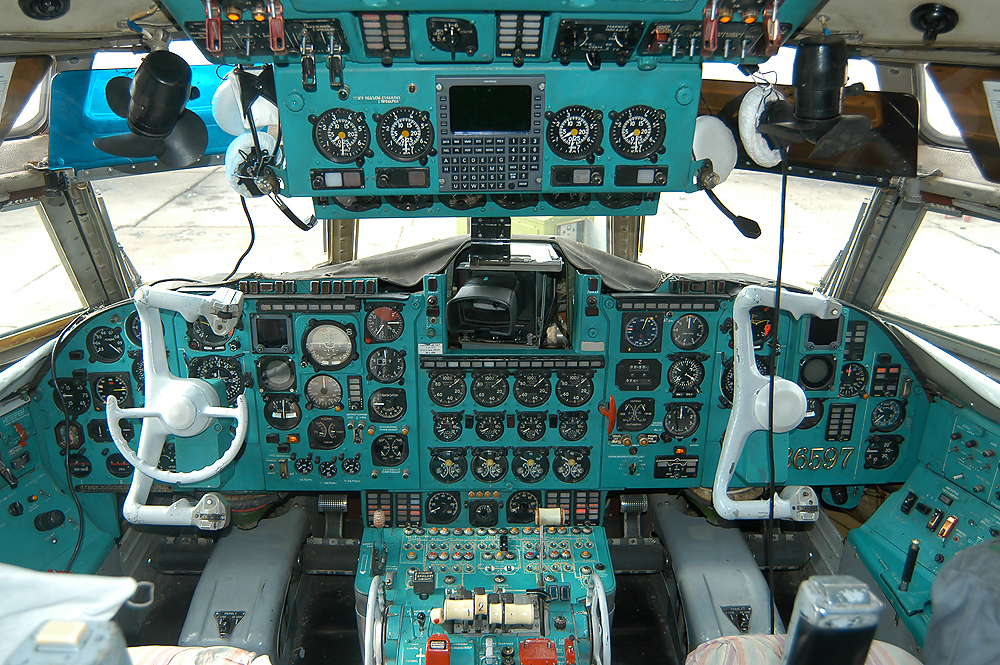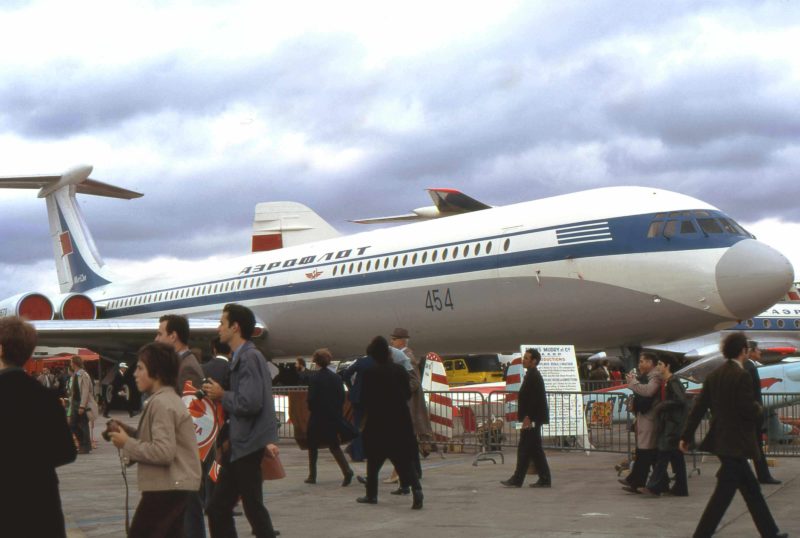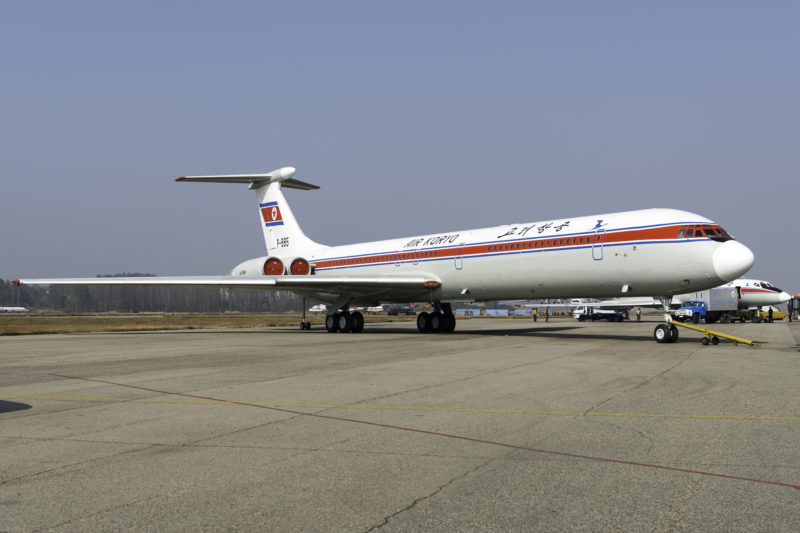The history of the Ilyushin Il-62
The Soviet Union had a jetliner (the Tu-104) and a long hauler (the Tu-114 propliner) but it took the Il-62 to be both, bringing the most far-flung corners of the empire, and the world, to Moscow at jet speed.
The story of Russia’s first long haul jetliner begins in the century before last, with the birth of aircraft designer Sergei Vladimirovich Ilyushin on March 30, 1894, in the Vologda Oblast in northeast Russia. After training in the Tsarist Army as a pilot in 1917, and as an aircraft technician in the Red Army after the revolution, his future as one of the world’s most famous aircraft designers was probably set in stone in late 1919 when a British Avro 504 fighter plane crashed near Petrozavodsk — he was one of the team who took the plane apart and transported it to Moscow to be reverse-engineered and built as the Soviet U-1 trainer, of which 707 were built. In 1921 he joined the Red Army Engineering Institute and the Air Force Science and Technical Committee in 1926. In 1931 he began working as an aircraft designer at TsAGI, and in 1933 became chief designer at the TsKB (Ts = Central, KB = Design Bureau) which in 1935 became the Ilyushin OKB.

The first production aircraft designed by the Ilyushin OKB was the Il-2 ground attack aircraft which was then the most produced aircraft of all time, with 36,183 built (including the Il-10 development, the number rises to 42,330). After World War 2, the focus turned to civil aviation – between 1950 and 1959, domestic air traffic within the Soviet Union grew tenfold. The Ilyushin OKB was at the forefront, with the first of 2,011 Il-12 and Il-14 propliners flying in 1950, and the four-engined long haul Ilyushin Il-18 turboprop following in 1957.
The Tupolev Tu-104 was doing great work and could stay up for two or three hours at a time, but the Soviet Union needed a true long haul machine, so in February 1960 Sergei Ilyushin himself presented a proposal for a four-engined passenger jet to the Soviet Council Of Ministers, and received a formal go-ahead on June 18. The Kuznetsov OKB, specialising in aeroengines, was simultaneously instructed to develop what would become the NK-8 turbofan engine.

The placement of the engines in pairs on the rear fuselage would later be controversial in the West as it so closely replicated the contemporary Vickers VC-10 produced in Britain. In fact the configuration was dictated by TsAGI on the basis that the Ilyushin OKB did not have the resources to engage in prolonged configuration studies and engine placement on the rear fuselage was considered scientifically correct and thus immutable. (Indeed engines attached to the wing by pylons remained anathema to Soviet airline design until the entry into service of the widebody Ilyushin Il-86 in 1980.)
In fact the layout was also shared with the Lockheed L-329 / L-1329 Jetstar business jet, against which there are no accusations of plagiarism, and has several advantages which are no doubt why it appealed to Vickers and Lockheed as well as Ilyushin — a very quiet passenger cabin, a clean wing optimised for aerodynamic efficiency, and a smaller rudder required due to the lack of asymmetrical power in the event of an engine failure.
Another noteworthy design element on the Il-62 is the distinctive ‘dogtooth’ indentation in the leading edge of the wing, which was added to create a powerful vortex over the wing at low speeds, localising the turbulent airflow of an incipient aerodynamic stall and protecting the high lift outboard wing. The flight controls were also fitted with a ‘stick shaker’ to warn of an approaching aerodynamic stall, and a ‘stick pusher’ which would physically force the control column forward if the aircraft reached a fully-stalled condition. This feature was met by resistance by pilots at the time, but is a feature of all T-tailed aircraft today.
The horizontal stabiliser is small for the size of the aircraft and the consequent aerodynamic load. This reduces cruise drag significantly (and structural weight a bit) at the expense of having the wing placed slighty further forward. This creates no issues in flight but in some loading regimes, can place the centre of gravity aft of the main landing gear, which gave rise to another Il-62 trademark, the retractable tail stand. is extended when the aircraft is parked. With the tail stand in place, loading and unloading can be done in any order without risk of the aircraft tipping up on its tail.
The first prototype, registered CCCP-06156, taxied under its own power at Khodynka airfield in Moscow, on September 19, 1962. The engines used initially were Ljulka AL-7 turbojets as the Kuznetsov NK-8 was still being readied for use. The AL-7 had many successful military applications such as the Sukhoi Su-7 Fitter and Su-9 Fishpot as well as the AS-3 Kangaroo cruise missile and even the Beriev Be-10 flying boat.

CCCP-06156 was formally unveiled to the country’s top brass including General Secretary Nikita Khrushchev at Khodynka on September 24. After that, the machine was dismantled and transported by road to Zhukovsky, south east of the capital, home of TsAGI and the Soviet Union’s main centre of aerospace research and development, where it was reassembled for flight testing. High speed taxi runs resumed on December 19, and the aircraft even made a few short hops into the air of a few seconds each.
The Il-62’s first flight was a successful thirty-four minute sortie on the morning of January 2, 1963 under the command of Captain Vladimir K. Kokkinaki, joined by First Officer Eduard I Kuznetsov, navigator V. F. Voskresenkiy, flight engineer I. B. Kuss, radio operator V. S. Siliminov, and project engineer P. V. Kazakov. A second prototype, CCCP-06153, was transported to Zhukovsky and after reassembly flew with Kuznetsov NK-8 engines on April 24, and also had redesigned ailerons for better roll control.
The Il-62 test programme suffered a major blow when, on February 25 1965, CCCP-06156 crashed at the start of its 127th flight. Under the command of Captain A. S. Lipko, during a maximum takeoff weight test, CCCP-06156 lifted off with a high angle-of-attack and low airspeed, and, unable to gain altitude, hit the airfield perimeter fence before crashing in the countryside beyond, with the loss of ten of the seventeen men onboard, three of whom (navigator Voskresenskiy, flight engineer Kuss and test engineer Kazakov) had been on the first flight.
Undaunted, a third prototype, CCCP-06176, made its way to Zhukovsky for a first flight on July 28, and production began at the famous Aircraft Factory Number 22 in Kazan, Tatarstan; CCCP-06170 and -06300, the first two production aircraft, joined the test programme on route-proving trials. On May 11, Captain Boris A. Anapov commanded a ten hour flight that covered 8,050 km (5,000 miles), and on July 9, flew the ship in an airshow at Moscow Domodedovo airport, leading a column of commercial aircraft in the display which unveiled the Soviet Union’s new flagship to the public. On July 11, another Kazan-built machine, CCCP-86666, left Moscow and overflew Murmansk, the North Pole, and Sverdlovsk (today Yekaterinburg) before returning to base, covering 8,940 km (5,556 miles) in in ten hours and 48 minutes; the purpose of the sortie was to check the avionics for navigation accuracy.

CCCP-86661 was the first production aircraft to be fully civilianised, with the anti-spin parachute in the tail replaced by a TA-6 auxiliary power unit, and was delivered to Aeroflot’s base at Krasnoyarsk in Siberia. The first revenue flight was performed on September 8, 1967 on the trunk route from Moscow to the Kazakh republic’s capital city of Alma Ata (today Almaty). The following week saw the Il-62 make its international debut, displacing the Tu-114 propliner from the transatlantic route to Montreal. The triumph and tragedy of the four-year test programme had paid off.
The first export customer for the Il-62 was Czechoslovakia’s flag carrier CSA, who got their first machine, OK-YBA, on October 29, 1969, followed by -YBB on November 28 for services to Moscow and a long-haul service to Jakarta via Damascus, Karachi and Rangoon (today Yangon). (As a star pupil of the Warsaw Pact airlines, CSA had been the first airline after Aeroflot to fly the Tu-104, and was even in the frame to operate the supersonic Tu-144 in the late 1970s.)
East Germany’s national carrier Interflug was next, DM-SEA arriving at Berlin Schonefeld on Lenin’s 100th birthday, April 22, 1970 to begin service to Moscow, followed by the Middle East — Cairo, Baghdad, Damascus, and later as far afield as Dubai, Tashkent, Havana, Hanoi, Lagos, Luanda, Karachi, Maputo and Singapore, as well as intra-European sectors such as Amsterdam, Prague, Athens and Paris.

Further export customers included the CAAC (Civil Aviation Administration Of China) and United Arab Airlines / Egyptair in 1971, TAROM of Romania and Cubana in 1972, and LOT Polish Airlines in 1973. Air France and Japan Air Lines both wet-leased Il-62s from Aeroflot for service to Russia and Japan, carrying dual titles in the Aeroflot livery. Mostly they were used on long haul trips – LOT put theirs straight into transatlantic service from Warsaw to New York, Toronto and Chicago serving the large Polish populations there, while TAROM initially used theirs on shorter trips but made it across the Atlantic in the end, to New York and Chicago, with a tech stop in Amsterdam.

A suggested modification to improve range was designated the Il-62D (D for Dahl’niy — “long range” in Russian), which involved using the rear of the main deck for additional fuel tanks; Sergei Ilyushin felt this was not ideal for either safety or efficiency, and instead worked towards the Il-62M (M for modifitseerovannyy — “modified”), the most important upgrade being the use of Solviev D-30 engines, which were turbofans with a higher bypass ratio than the NK-8, a better engine nacelle, lower exterior noise, and a new clamshell reverse thrust bracket.
Other upgrades were the addition of a 5,000 litre tank in the tail fin, asymmetric spoiler control to assist the ailerons in roll, refined elevators for better pitch control, an upgraded APU, better cockpit lighting, new control yokes and ICAO category II-compliant avionics.
After 94 standard Il-62s were delivered, production switched to the Il-62M, the first example, CCCP-86656, getting into the air on April 15, 1972. Test flying was extensive and even included a trip to South America to evaluate the aircraft’s performance at “hot and high” airfields. The certification process was complete by November 1973 and the first revenue service with Aeroflot took place on January 8, 1974.

All of the airlines who operated the original Il-62 took the M version, mostly in a one-for-one fleet upgrade. Three new export customers were found — TAAG Angola (two aircraft were delivered, D2-TIF and -TIG), DETA Mozambique (one aircraft, registered C9-BAE), and Choson Minhang (today Air Koryo) of North Korea, who took four passenger liners and a head of state Salon aircraft.

After the success of the Il-62M, a few further variants were produced in very small numbers, such as the Il-62MK, a shorter range version intended for high frequency short range operations (sixteen for Aeroflot and two for Interflug); and the Il-62MU, a combi (just one, RA-86586, operated by the Kazan factory’s own airline, KAPO Avia). The Il-62M-250 was a stretched variant, boasting an extra 22 feet and 3 inches (6.8 metres), but never left the drawing board.
While the Il-62 had an excellent safety record, with only a handful of fatal accidents, LOT Polish Airlines’ experience was noteworthy for the loss of two aircraft in identical accidents at Warsaw, seven years apart. LO 007, operated by SP-LAA, the first Il-62 delivered to the airline, was landing after an overnight flight from New York on the morning of March 14, 1980, when it initiated a go-around due to a landing gear warning light. Upon the application of full power, engine number two engine exploded, cuting control lines to the tail and causing an immediate uncontrollable descent into the ground just outside the airport perimeter with the loss of all 87 on board.
In an eery repetition, on May 9, 1987, SP-LBG, a Il-62M, was operating LO 5055 to New York; climbing hard to comply with an air traffic control instruction to avoid a block of military airspace in its path, number two engine exploded, taking out engine number one and all of the flight controls except pitch trim, and starting a fire in the rear cargo hold. Remarkably, the crew were able to keep the disabled machine in the air for thirty-one minutes and nearly made it back to the runway at Warsaw, but in the end the ship was unflyable and crashed at the opposite end of the airport of the 1980 tragedy, taking with it a further 183 lives.
In the wake of the second accident, LOT pioneered some safety upgrades to the Il-62, including duplication of flight control systems, replacing flammable elements in the cargo hold, installation of smoke detectors, and upgraded engine vibration detection systems and fire detection systems.
While 1989 itself was bad, with two major crashes (Interflug due to pilot error and Cubana due to windshear), the two decades that followed, which were the years with the most Il-62s flying, were notable for seeing no fatal accidents. Compared to the 707, VC10 and DC-8, the Il-62 had the lowest incidence of accidents, with twenty-two fatal accidents and a further eleven aircraft written off without fatalities.
Although the country that created the Il-62, the Soviet Union, had ceased to exist, the 1990s were in many ways the Il-62’s halcyon era, as the deregulation of the Russian airline scene saw the splintering of an industry that was up to that point sedate and top heavy into new flag carriers as the former Soviet republics became independent nations. What had previously been Aeroflot’s Uzbek base at Tashkent became Uzbekistan Airlines, inheriting a fleet of four Il-62 and eleven Il-62Ms to begin serving cities as far afield as London and Seoul. Air Ukraine, previously Aeroflot’s Kiev operation, sprang to life with seven Il-62Ms and opened up transatlantic flights to New York and Toronto in one direction, Bangkok in the other.

In the Russian domestic scene, new independent airlines multiplied — Interavia, Aviaenergo, Dalavia, SAT, and VIM all flew large fleets of the Il-62 in the 1990s. Forty-five machines passed through the hands of Domodedovo Airlines alone. At most of these airlines, the ageing Il-62s were flown hard enough to peel the paint off — some averaged seventeen hours of use per day. In the Czech Republic, ex-CSA machines were snapped up cheaply by budding airline moguls to create Espe Air Prague, Egret BMI and Bemoair.

Aeroflot itself, while a fraction of it’s former size, was able to benefit from the reduction in political tension — the peace dividend – in the world, and catered to an increase in international flying. New routes were added including Moscow-Larnaca-Sal-Rio-Sao Paolo, and Moscow-Shannon-Havana-Panama-Managua. In fact the Il-62M fleet was doing so much transatlantic flying that on certain days of the week, eight aircraft were dropping into Shannon for refuelling in the space of a few hours — each way.
An interesting aside to the Il-62 and Aeroflot’s story with Shannon: starting in the 1980s, Aeroflot (after complaining of high fuel prices at Shannon and moving some of their stopover traffic to Gander in Canada) came to an arrangement with the handling agent at Shannon that the Soviet Union, and later Russia, could build their own fuel farm and deliver their own fuel to the airport. This fuel was supplied by the Soviet, and later Russian, government. By the mid 1980s, 3,000 Aeroflot movements a year were being fueled, with regular deliveries of 1.25 million gallons of top quality Jet A-1 at a time on tankers from the Black Sea. For Aeroflot, the pleasing collateral benefit of this arrangement was that as the fuel came from their government, it somehow didn’t show up on Aeroflot’s financials. So the story goes, Aer Rianta then offered Aeroflot free landing fees and ground handling services (parking, steps, ground power, line maintenance etc) in return for the ability to sell off some of this magic free fuel to other airlines just a little less than at market rate. This made the airport a popular stopover and attracted TWA, Rich International, American Trans Air, Worldways and TAROM on their way to and from the Atlantic. Hey, get a little, give a little.
As the 1990s rolled into the 2000s, the availability of middle-aged Boeing and Airbus jets with comparable seating capacity but far superior economics finally spelled out a gradual end for the Il-62 and other Soviet-era hardware. Aeroflot’s last thirteen Il-62s were stood down on November 1, 2001. Other Russian carriers followed suit as the decade wore on. A common sight in provincial Russian airports for a while was old Ilyushins and Tupolevs parked around the fringes of the fields, streaked with mildew, birds nests in engine cowlings. Today most have been scrapped.
The final production Il-62 was built in 1995 without a delivery customer and put into storage. KAPO, the Kazan Aircraft Production Association, the latter-day owner of Aircraft Factory Number 22, formed KAPO Avia in 1999 and put RA-86586 into service themselves, flying charter trips or leases on behalf of some of the world’s most obscure airlines — Magma Airlines, BGB Air, Luk Aero — before it was acquired by Kazakh broker Sayat Air and reregistered as UP-i6205.

The rock-bottom price and long range of the Il-62M, many of which were still available with low airframe hours, and with plenty of old boys who knew how to fly them still around, whose more adaptable, English-speaking erstwhile colleages had gone off and by hook or by crook got themselves A320 and 737 typeratings and jobs with the emergent national carrier, were quite happy to drag their old Aeroflot uniform out of the closet in Almaty or Osh and go and fly Il-62s in Iran, Sudan or Equatorial Guinea.
Iran in particular represented rich pickings for airliners with pilots for hire, as documented in more detail in the chapter about the Tupolev Tu-154, as the country, geographically vast and with a huge and growing population, was restricted from buying new planes due to a diplomatic falling-out with the United States. Kazakh-sourced and –crewed Il-62s came in towards the tail end of the peroid that this capacity gap was filled with Soviet hardware, but alas sister ship UP-i6208, an older ship delivered to Interflug in 1989, crashed on landing in Mashhad on July 24, which brought Aria Air’s experiment to a premature end. For fans of the Il-62 this is a lost alternate future – Aria had big plans for the Il-62, with a fourth Il-62, UP-i6210, arriving from Kazakhstan to Tehran just eight days before the crash in the partial livery of previous operator InvestAvia, never to enter service with Aria Air. Expansion was not only planned to a wider Iranian domestic network, but international flights to Kuwait, Moscow, Istanbul, and Bombay, with more Il-62s to come. UP-i6205’s ferry flight to Fujairah in 2014 will almost certainly be its last, with only a thousand hours at most in the logbook — such is the price of being born too late.

Cubana was one of the last major airlines to fly the Il-62, with transatlantic flights (to Madrid, Paris, Frankfurt and Las Palmas) and routes throughout Latin and South America gradually being reduced to neighbouring Santo Domingo, Mexico City, Recife and Caracas. The last aircraft, CU-T1284, was stood down on March 1, 2011.

The following year, North Korea’s flag carrier Air Koryo bought CU-T1280, reregistered it P-886P and in July 2012 flew it from Havana to Pyongyang where it was scrapped for parts to support North Korea’s surviving pair of passenger machines (P-881 and P-885) plus Kim Jong Un’s head of state aircraft (‘Air Force Un’). Having once flown as far afield as Moscow, Berlin, Sofia and Belgrade in the halcyon days of the 1980s, by 2012 Air Koryo mainly flew the Il-62 on the trunk route to Beijing, with occasional appearances at Shenyang, Moscow, Bangkok and Macau. On the last day of 2012, China banned the type due to noise; P-881 went to the air force as a back-up for Air Force Un, leaving P-885, North Korea’s first Il-62M (delivered in 1979), to remain in service.

Even in a country with a tiny geographical footprint, an economy operating (at least on face value) at a very low level, a population unable to travel, and the type banned on the main international trunk route (Beijing), there is still room for P-885 to make a living in North Korea, as uplift is occasionally needed on ad hoc domestic runs (such as to transport a delegation to Mount Pektu, or a workers charter between Pyongyang and the country’s second biggest city, the industrial hub of Hamhung). Air Koryo’s once-a-week flight to Vladivostok, when demand outstrips the supply of seats on the usual Il-18, is subbed with the Il-62, which has no environmental restrictions against it in Russia. Don’t dream it’s over.

One more Il-62 was built, over a whole decade later — on October 8, 2009, RA-86495 was completed using parts at Kazan for the Russian government. Oddly, it was given the same manufacturer’s serial number and registration as a 1977-build Il-62MK that flew for Aeroflot and the Soviet military and later with Moscow Airlines; that original machine was damaged beyond repair in 2002 and scrapped at Chkalovsky. The second incarnation of RA-86495 remains in service to this day with the Russian Air Force’s 223rd Flight Unit which specialises in transport and logistics up to and including head of state transportation.
Comparison to the VC-10 is inevitable given the similar appearance of the two aircraft, and western chauvinism insists that the Vickers machine must be superior to the “VC-10ski”, but while the VC-10 had inferior range and only 54 were produced, Russia’s first long range jet was a success by any standard — 295 produced between 1963 and 1995 (plus 2009’s one-off), flying for countless airlines in over thirty nations including 213 passing through the fleet of Aeroflot. Today the Il-62 remains in service with one airline (North Korea’s Air Koryo) and a number of governments including Sudan, Russia, The Gambia and Ukraine. Of all the aircraft designed by Sergei Ilyushin, it is the silhouette of an Il-62 that is carved into his headstone as his greatest achievement — the flagship of the Russia’s Soviet era.
Sam’s Travel Hacks
As a frequent flier, I recommend book flights and compare prices on Skyscanner and JustFly for the best deals on the internet. We have put together many useful travel tips and airfare promotions in my Smart Travel section to guide you travel in more luxury with lower price!






